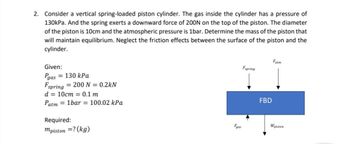Question

Transcribed Image Text:2. Consider a vertical spring-loaded piston cylinder. The gas inside the cylinder has a pressure of
130kPa. And the spring exerts a downward force of 200N on the top of the piston. The diameter
of the piston is 10cm and the atmospheric pressure is 1bar. Determine the mass of the piston that
will maintain equilibrium. Neglect the friction effects between the surface of the piston and the
cylinder.
Given:
Pgas = 130 kPa
Fspring 200 N = 0.2kN
d = 10cm 0.1 m
Patm = 1bar = 100.02 kPa
Required:
mpiston =? (kg)
Faas
Espring
FBD
Fatm
Wpiston
Expert Solution
This question has been solved!
Explore an expertly crafted, step-by-step solution for a thorough understanding of key concepts.
Step by stepSolved in 2 steps
